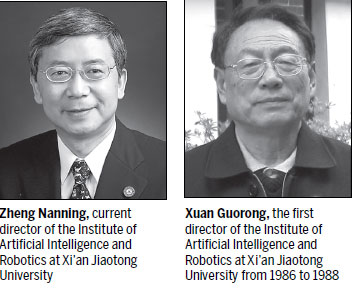Jiaotong University experts build their vision for the future
When the new generation of medium carrier rocket named Long March VII was launched on June 25 in Wenchang, Hainan province, a group of people in Xi'an, Shaanxi province, shared in the celebration.
They are professors and experts working with the Institute of Artificial Intelligence and Robotics at Xi'an Jiaotong University, who designed and developed a visual measurement system, algorithm and software products for the Ao Long I aerobat, the main load of the Long March VII rocket.
The institute will celebrate its 30th anniversary on Saturday.
The school was founded in 1986. Its predecessor was the computer control teaching and research laboratory under the school's automatic control department.
It was one of the earliest professional research institutions to carry out research on artificial intelligence and robotics in China.
Xuan Guorong, the first director of the institute from 1986 to 1988, made great contributions to the research and development of AI.

The 5,500-square-meter institute is a support unit of the National Engineering Laboratory for Visual Information Processing and Application and the Cognitive Science and Engineering Center for international studies.
In cooperation with globally-renowned scholars, the institute has made a range of achievements. With an edge in the disciplines of pattern recognition and intelligent systems, the school recruits more than 160 graduate students and post-doctoral assistants annually.
Under the leadership of Zheng Nanning, director of the institute and also an academician of the Chinese Academy of Engineering, the institute was among the first group of winners of funds from Foundation for Innovative Research Groups of the National Natural Science Foundation of China in 2000.
The institute focuses on the studies of visual signal statistical characteristics, primary visual models, computer graphics and machine vision information computing. Their work combines AI information processing based on computer vision and pattern recognition with the advanced developments of related sectors in the AI field.
It also specializes in the exploration and modeling of mathematical mechanisms of intelligent systems, ultralarge scale integrated circuit design for computing vision and images, intelligent control, recognition systems and various image processing methods and techniques.
In the field of visual information processing, the institute has a well-established and soundly-structured research team. They have undertaken 51 national science and technology projects, 21 provincial and ministerial level projects, 30 corporate commissioned projects and two other important research projects.
The institute has filed more than 100 applications for invention patents. Of them, 88 were granted, including three authorized abroad. It has also obtained 29 software copyrights.
It has won a series of awards, including one second-place prize from the National Awards for Technological Invention, two second-place prizes from the National Science and Technology Progress Awards, and four first-place prizes from provincial and ministerial level science and technology awards.
Two of its researchers were winners of the Chinese Youth Awards for Science and Technology.
(China Daily 09/23/2016 page16)








